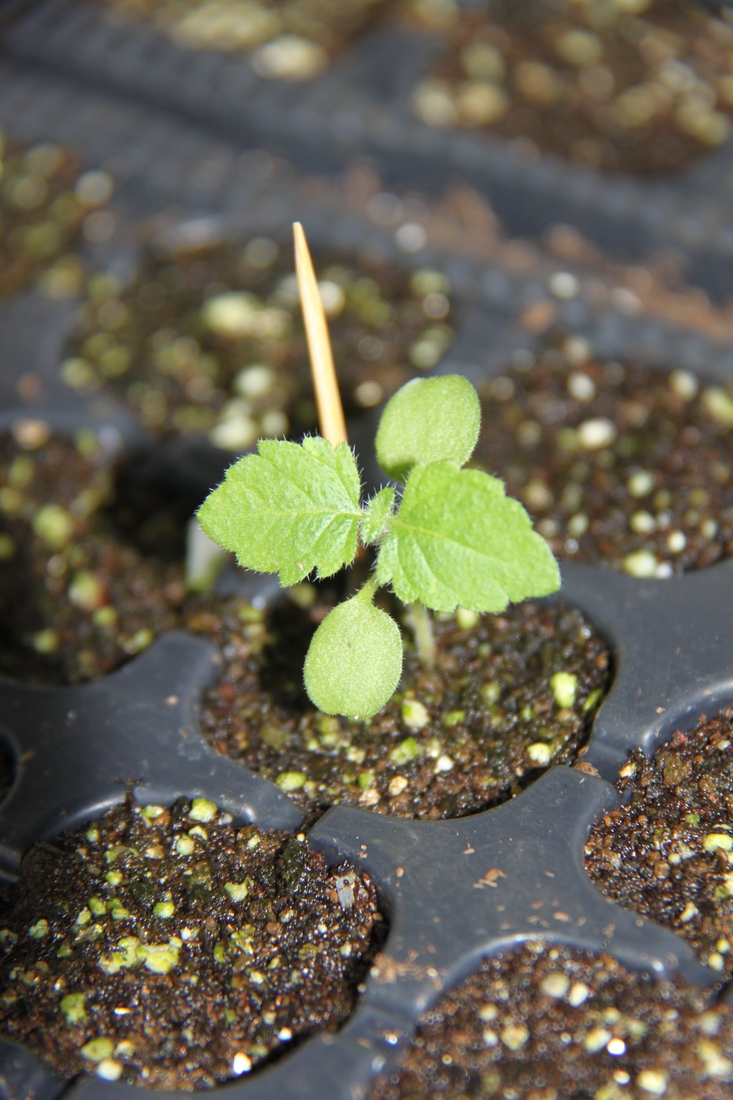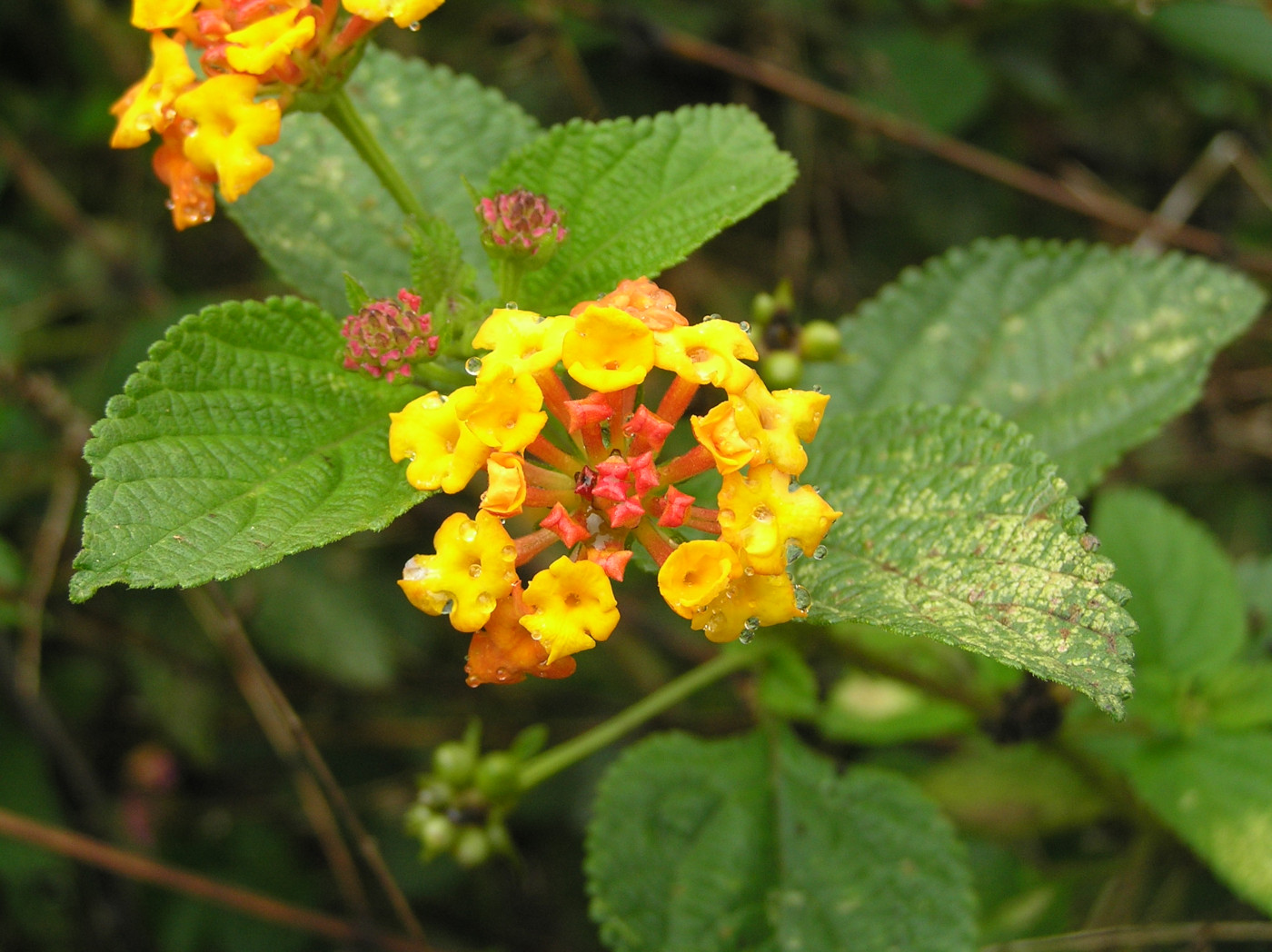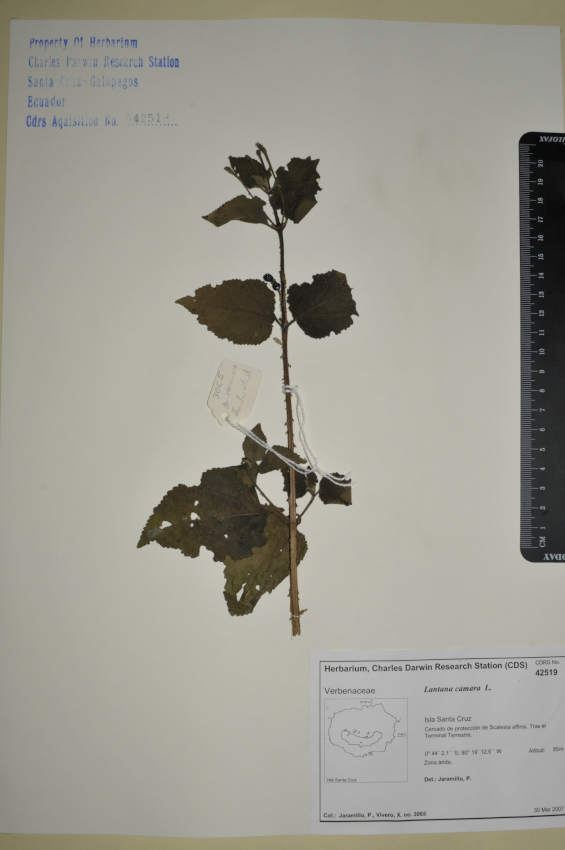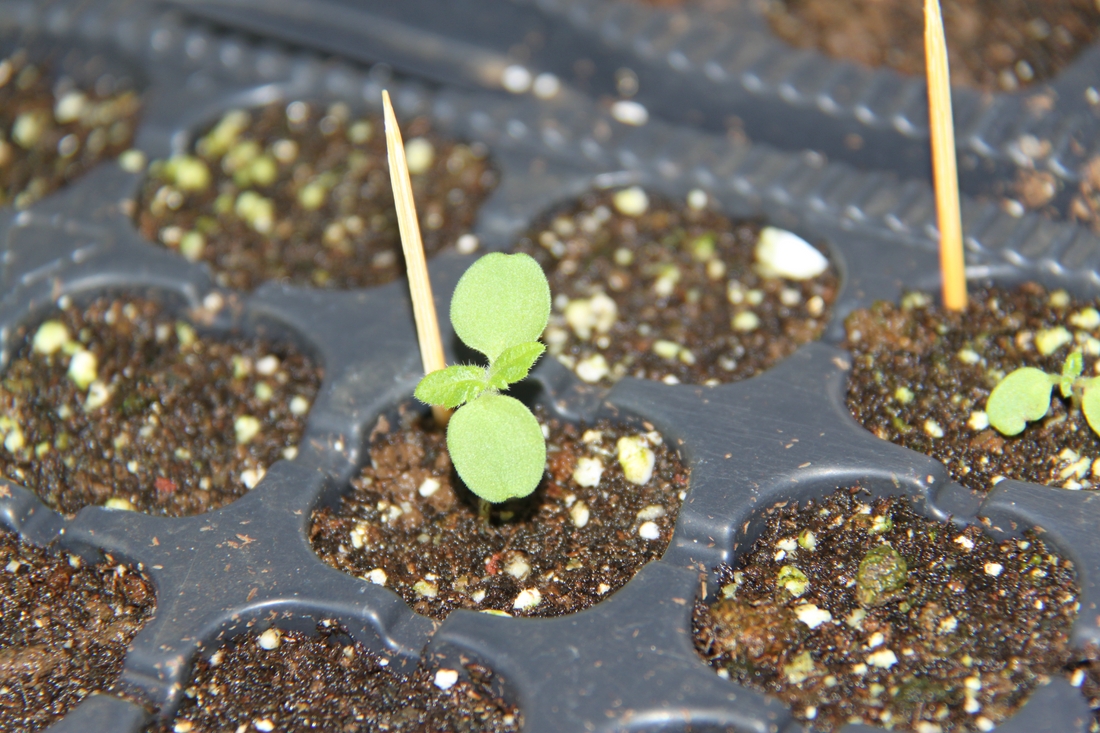Galapagos Species Database
The Galapagos Species Database shares the information about the species from our Natural History Collections.
Lantana camara
supirrosa, curse of India, koster's curse, multicolored lantana, spanish flag










The supirrosa is a spiny shrub 2 to 3 m high. It has beautiful flowers in vibrant colors (yellow and red). The plants are hybrids selected for the color of their flowers.
The supirrosa is a spiny shrub 2 to 3 m high beginning to bear fruit at 2 years of age. It has beautiful flowers in vibrant colors (yellow and red). The seeds are dispersed by birds. The plants are hybrids selected for the color of their flowers.
Domain
Eukaryota
Kingdom
Plantae
Phylum
Magnoliophyta
Class
Magnoliopsida (= Dicotyledoneae)
Order
Lamiales
Family
Verbenaceae
Genus
Lantana
Species
camara
Taxon category: Accepted
Syn.: Lantana armata Schauer
Taxon origin: Introduced - established
Preference for an altitude zone in Galapagos: Dry zone - transition zone
Habitat preferences: Grows as a weed on cultivated land, fence lines, pastures, rangelands, and waste areas. Thrives in both dry and wet areas. Often found growing in valleys, mountain slopes, steep, rocky rangelands, and coastal areas. Capable of flowering year-round in warm regions. Found in arid lowlands and moist uplands in Galapagos.
Trophic role: Primary producer
Reproductive biology: Begins to flower at 2 years of age. Seeds are dispersed by birds and rodents.
Growth form: Shrubs
Distribution origin: Central America
Mode of introduction: Intentional
Introduction Pathway: Intentional
Subpathway: Agriculture/Horticulture
Introduced status: Naturalized
Invasive status: Invasive
Impact in Galapagos: On Floreana it is a serious problem for the native forest, hills, and agricultural area.
Impact elsewhere: Known as invasive in many parts of the world for agricultural and natural ecosystems where they invade and displace native plants.
Control methods elsewhere: Biological: The species has been the focus of many biological control projects, but most have not been successful because in most cases, plants are hybrids or of unknown origin. Mechanical: Seedlings should be pulled manually. Chemical: Juveniles and adults should be treated with herbicide.
Year of first record: 1977
Map of specimen collection localities or observation records for this species in our collections database.
Distribution: San Cristobal, Santa Cruz, extensive distribution on Floreana, limited distribution on Isabela, originally from Central America.
- Hamann, O. (1984) Changes and threats to the vegetation. In: Perry, R. (ed.) Key Environments: Galapagos. Pergamon Press, Oxford, p. 115-131.
- Clavijo, P. Valdebenito, H. & Hurtado, F. (1991) Plantas introducidas en las areas urbanas de las islas Galapagos. Typescript reports in files of Botany Dept.
- Jaramillo, P. (1998) Distribución Espacial de la Vegetación Vascular y Dispersión de Especies Introducidas dentro del Parque Nacional Galápagos. Tesis de Doctorado en Biología, Universidad Central del Ecuador. Especialización ECOLOGIA DE POBLACIONES.
- Jørgensen, P.M. León-Yánez, S. (eds.) (1999) Catalogue of the Vascular Plants of Ecuador. Monographs in Systematic Botany from the Missouri Botanical Garden 75. Missouri Botanical Garden Press, St. Louis, 1181 pp.
- McMullen, C.K. (1999) Flowering plants of the Galapagos. Cornell University Press, Ithaca and London, 370 pp.
- Tropicos.org. (2017) Database of Missouri Botanical Garden. Tropicos.org. Missouri Botanical Garden. 06 Oct 2017 <http://www.tropicos.org
- Funk, V.T. Hollowell, T., Berry, P., Kelloff, C. & Alexander, S.N. (2007) Checklist of the Plants of the Guiana Shield (Venezuela: Amazonas, Bolivar, Delta Amacuro; Guyana, Surinam, French Guiana). Contributions from the United States National Herbarium 55: 1-584.
- Hokche, O. Berry, P.E. & Huber, O. (2008) Nuev. Cat. Fl. Vas. Venezuela 1–860.
- Causton, C.E. Sevilla, C. (2008) Latest Records of Introduced Invertebrates in Galapagos and Measures to control them. Galapagos Report 2006-2007, CDF, GNP and INGALA, Puerto Ayora, Galapagos, Ecuador, p. 142-145.
- Itow, S. (1997) List of Plant Specimens collected in the Galápagos Islands, Ecuador. Bulletin of the Faculty of Liberal Arts, Nagasaki University, Natural Science, 38 (1): 53-144.
- Quintana, M.C. (2010) Wild plants in the dry valleys around Quito-Ecuador. Publicaciones del Herbario QCA, PUCE. Quito-Ecuador, 266 pp.
- Carvajal, Y. (1985) Status and Rgeneration of Scalesia pedunculata in Galápagos Annual Report 1986-1987. Charles Darwin Research Station. Pg 40-42
- Jaramillo, P. (1999) Impacto de las Actividades Humanas sobre las comunidades de plantas nativas en el Parque Nacional Galápagos. Informe Galápagos, 50-55 (Eds P. Ospina and E. Muñóz). Quito-Ecuador: Fundación Natura y el Fondo Mundial para la Naturaleza (WWF).
- Jaramillo, P. (1999) Impact of Human Activities on the Native Plant Life in Galapagos National Park. Galapagos Report, 50-55 (Eds P. Ospina and E. Muñóz.). Quito-Ecuador: Fundación Natura and World Wildlife Fund (WWF).
- Tapia, W. Jaramillo, P. (1999) Las especies introducidas agresivas en las islas Galápagos y medidas tomadas para su control. El Parquero. 40 años del Parque Nacional Galápagos, 14-16.
- Guézou, A. Trueman, M., Buddenhagen, E., Chamorro, S., Guerrero, A.M., Pozo, P., Atkinson, R. (2010) An extensive Alien Plan Inventory from the Inhabited Areas of Galapagos Plos One/ www.plosone.org. Volume 5/ Issue 4/e10276
- Castro, S. A. Curtis, C.D., Silva, L., Torres-Santana, C.W., Reyes-Betancort, J.A., Atkinson, R., Jaramillo, P., Guézou, A. & Jaksic, F. M. (2010) Floristic homogenization as a teleconnected trend in oceanic islands. Diversity and Distributions, (Diversity Distrib.): 1-9.
- Lawesson, J.E. (1987) Plantas exóticas en las Islas Galápagos, un resumen. Memorias. Taller sobre investigación Botánica y manejo en Galápagos. Pg. 17-23.
- Gardener, M. Atkinson, R., Rueda, D. & Hobbs, R. (2010) Optimizando la restauración de la degradada parte alta de Galápagos: un marco conceptual. Informe Galápagos 2009-2010.
- Gordillo, J. (1987) La colonización de San Cristobal, Islas Galápagos una Perspectiva Histórica Memorias. Investigación Botánica y Manejo en Galápagos.Pg. 278-281
- Davis, S. (1987) El centro mundial para el monitoreo de la conservación y las floras insulares amenazadas. Memorias. Taller sobre investigación Botánica y Manejo en Galápagos. Pg. 304-314
- Atkinson, I. A. E. (1987) Algunas consideraciones sobre la cartografía y clasificación de la vegetación en las Islas Galápagos. Memorias. Taller de Investigación Botánica y Manejo en Galápagos. Pg. 114- 131.
- Adsersen, H. (1987) Cuadrantes permanentes de vegetación en Galápagos Memorias. Investigación Botánica y Manejo en Galápagos. Pg. 166-171
- MacDonald, I. A. W. (1987) Estrategias para limitar la invasión de organismos introducidos a las áreas protegidas Memorias. Investigación Botánica y Manejo en Galápagos. Pg.210-223
- Lawesson, J.E. Ortiz, L. (1987) Plantas Introducidas en las Islas Galápagos Memorias. Investigación Botánica y Manejo en Galápagos. Pg.224-235
- Lawesson, J.E. Hamann, O., Black, J. (1987) Recopilación de las recomendaciones del taller: Investigación Botánica y Manejo en Galápagos Memorias. Investigación Botánica y Manejo en Galápagos. Pg.329-336
- Jaramillo, P. (1999) Impacto de las Actividades Humanas sobre las comunidades de plantas nativas en el Parque Nacional Galápagos. Informe Galápagos, 50-55 (Eds P. Ospina and E. Muñóz). Quito-Ecuador: Fundación Natura y el Fondo Mundial para la Naturaleza (WWF).
- Jaramillo, P. (1999) Impact of Human Activities on the Native Plant Life in Galapagos National Park. Galapagos Report, 50-55 (Eds P. Ospina and E. Muñóz.). Quito-Ecuador: Fundación Natura and World Wildlife Fund (WWF).
- Gardener, M. R. A. Tye and S.R. Wilkinson (1999) Control of Introduced plants in the Galapagos Islands. Twelfth Australian Weeds Conference, Tasmania Weed Society. Pp 396-400.
- Tye, A. M. C. Soria and M. R. Gardener (2002) A strategy for Galapagos weeds. In Veitch, C. R. and Clout, M. N. (eds.) Turning the tide: the eradication of native species. IUCN SSC Invasive Species Specialist Group. IUCN, Gland, Switzerland and Cambridge, UK. IUCN SSC Invasive Species Specialist Group. IUCN, Gland, Switzerland and Cambridge, UK.
- Thomas, S.E. Evans, H.C., Cortat, G., Koutsidou, C., Day, M. Ellison, C.A. & (2021) Assessment of the microcyclic rust Puccinia lantanae as a classical biological control agent of the pantropical weed Lantana camara Thomas, S. E., Evans, H. C., Cortat, G., Koutsidou, C., Day, M. D., & Ellison, C. A. (2021). Assessment of the microcyclic rust Puccinia lantanae as a classical biological control agent of the pantropical weed Lantana camara. Biological Control, 160, 104688.


Dispersal propagule: Seed
Seeds are dispersed by birds and rodents.